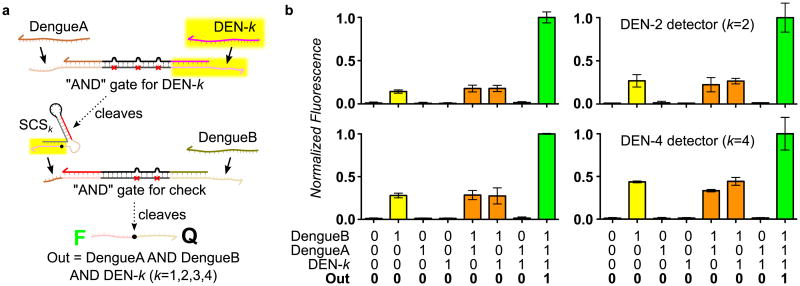Figure 3.
Example application of the SCS in a multi-layer diagnostic logic circuit. a) Design of multi-layer diagnostic logic circuits for detection of sequences from the genomes of all four dengue serotypes. The circuit template for serotype DEN-k (k=1,2,3,4) requires the presence of two conserved sequences from the dengue viral genome (DengueA and DengueB) and one sequence specific to the serotype of interest (DEN-k). This is implemented by DNAzyme displacement “AND” gates with mismatched inhibitors,[18] which are connected by a SCS molecule. When both upstream inputs are present, the active upstream DNAzyme cleaves the SCS, producing an activator that serves as one input to the downstream gate. If the second input to the downstream gate is also present, the downstream DNAzyme is activated and we observe this via loss of FRET following substrate cleavage. The upstream “AND” gate uses the 3 mismatch design characterized in Supplementary Figure 1, whereas the downstream gate uses an asymmetric pattern of mismatches because the activator produced by the SCS can displace into the catalytic core. We derived detection circuits for all four dengue serotypes (DEN1-4) by modifying only the domains highlighted in yellow. b) Demonstrations of serotyping circuits for DEN1-4, which show correct operation of all four instantiations of the three-input “AND” circuit template. Each serotyping circuit was characterized using all eight combinations of the two conserved sequences and the correct serotype-specific sequence. Variations in the normalized fluorescence levels (i.e., different levels of activation and leakage) may be attributed to variations in the stability of the corresponding SCSk structure in each case. Error bars represent the 95% confidence interval from three replicate experiments.

